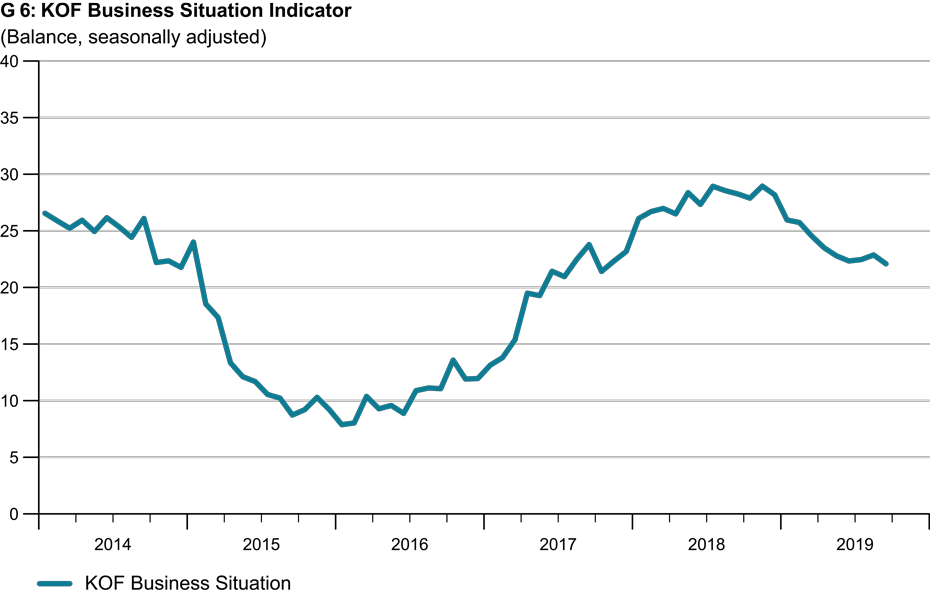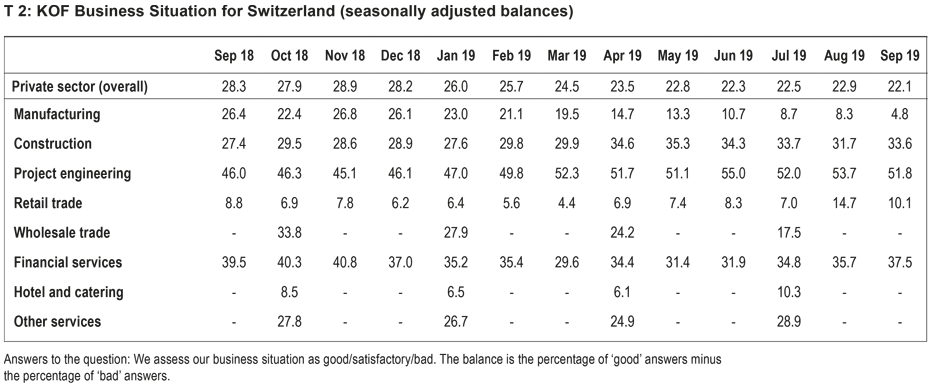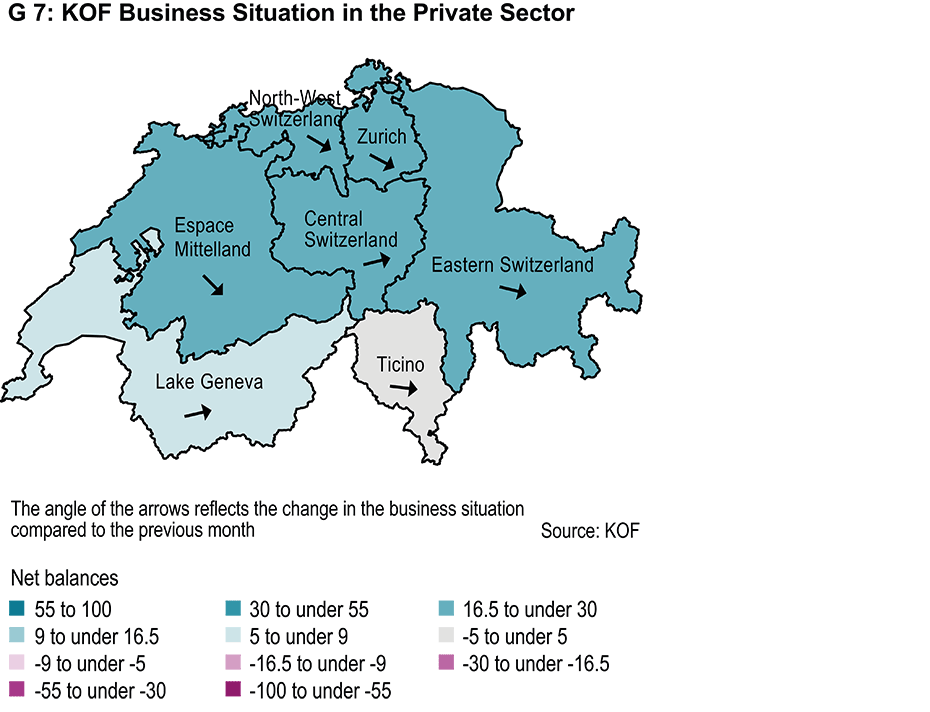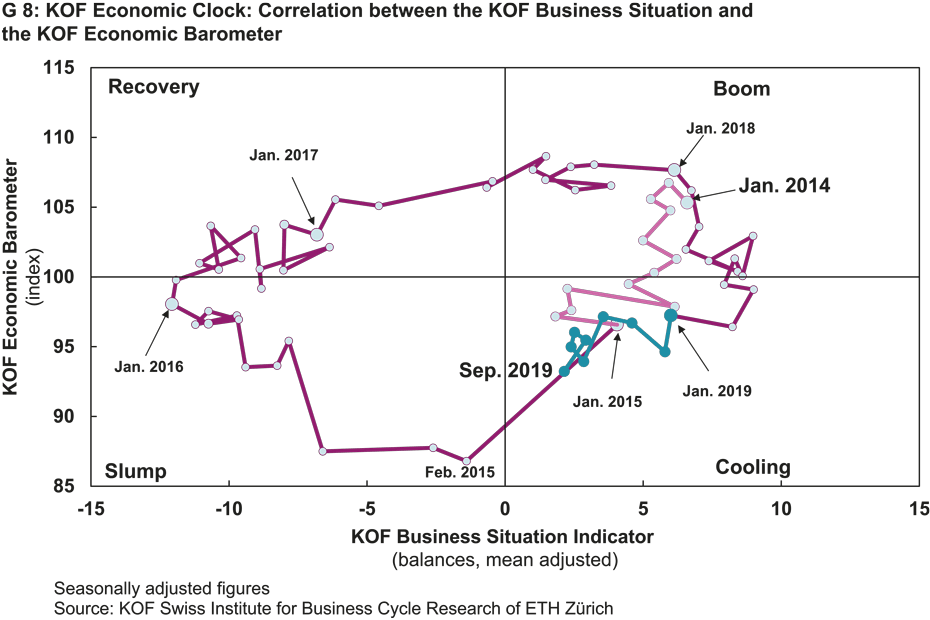KOF Business Situation Indicator: Business Situation Worsens Again
- KOF Business Situation Indicator
- KOF Bulletin
The KOF Business Situation Indicator declined noticeably in September (see G 6). Following stable figures for the business situation during the summer months of July and August, it then dropped again in September. The Swiss economy is facing a difficult environment and is running out of steam.

In the manufacturing industry, the indicator’s downward trajectory continued, posting the tenth drop in a row. Businesses in the manufacturing industry report strong falls in demand for their products. Retailers also took a hit in September. However, in this sector, the business situation had been developing positively in previous months. The retail sector is therefore in a better position now than it was say this spring.
A slight slowdown has also occurred in the project engineering sector, although the situation remains very good for project engineering firms. Businesses in the construction sector along with financial service providers and insurers report a more favourable business situation than the previous month. Wholesalers, hotel and catering companies and the other service providers were last surveyed in July. The hotel and catering sector and other service providers reported an improvement in that month, whereas the situation for wholesalers had worsened slightly (see T. 2).

In regional terms, the Business Situation Indicator fell slightly in most regions. This is apparent for instance in Espace Mittelland, North-West Switzerland, the Zurich region and Eastern Switzerland. Although this month’s fall in Eastern Switzerland is very slight, a negative trend has been establishing itself here over the last few months. It appears that in particular the manufacturing sector in Eastern Switzerland is exposed to weak foreign demand. The business situation has hardly changed in Ticino. It improved very slightly in the Lake Geneva region and Central Switzerland.


Explanation
Graph G 6 presents the KOF business situation across all sectors covered by the survey. The business situation in sectors which are surveyed on a quarterly basis is kept constant during the intervening months.
Graph G 7 presents the business situation in the main regions pursuant to the Federal Statistical Office. The regions are coloured according to business situation. The arrows in the regions indicate the change in the business situation compared to the previous month. An upward-pointing arrow, for instance, indicates that the situation has improved over the previous month.
The KOF Economic Clock (Graph G 8) plots the Business Situation Indicator against the KOF Economic Barometer. The Business Situation indicator represents the current economic situation, whilst the Barometer provides an early indicator of any changes in activity. The clock can be divided into four quadrants. During the recovery phase the business situation is below average, whilst growth prospects are above average. During the boom phase both the business situation and prospects are above average. During the cooling phase the business situation is below average whilst prospects are declining. During the slump phase both the business situation and prospects are below average. Theoretically, the graph should move through the quadrants in a clockwise direction over time.
The KOF business situation is based on more than 4,500 reports from businesses in Switzerland. Each month, companies are surveyed in the economic sectors of industry, retail trade, construction, project engineering and financial and insurance services. Businesses in the hotel and catering sector, wholesalers and other service providers are surveyed on a quarterly basis in the first month of each quarter. Among other questions, the companies are asked to assess their current business situation. They may class their situation as “good”, “satisfactory” or “bad”. The balance of the current business situation is the percentage difference between the answers “good” and “bad”.
Contact
KOF Konjunkturforschungsstelle
Leonhardstrasse 21
8092
Zürich
Switzerland
